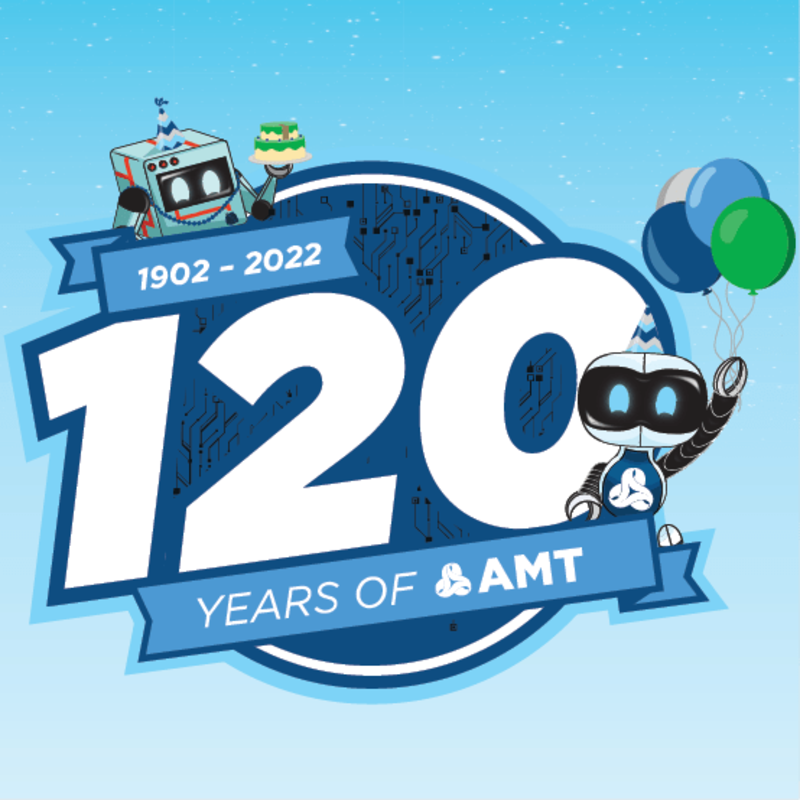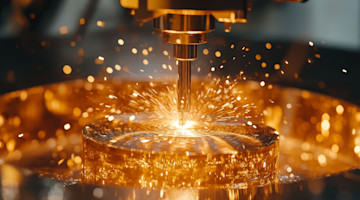It was the year of the first college football bowl game, the 1902 Rose Bowl, Michigan vs. Stanford, with the Wolverines so dominant (49-0) that the organizers in Pasadena skipped football matchups for the next 13 years.
Yet clearly, the Rose Bowl has endured.
The first dedicated movie theater opened in Los Angeles that year, the Electric Theater. Its opening feature was “Capture of the Biddle Brothers,” produced by the Edison Manufacturing Company – yes, as in Thomas.
The film industry hasn’t looked back.
That year Theodore Roosevelt became the first president to ride in a car – an electric vehicle – a Columbia Electric Victoria.
And here we are, 120 years on, and EVs are back in a big way. (President Joe Biden after driving a fully electric Ford F-150 Lightning on a track in Dearborn: “This sucker is quick.”)
1902 was the year that the National Machine Tool Builders’ Association (NMTBA) was established, an organization dedicated to what were then the elements of advanced manufacturing technology, including milling machines and lathes, grinders, and presses. A quarter century later, in 1927, the first National Machine Tool Builders’ Exposition was held in Cleveland, Ohio.
Although the 20th century saw two world wars, the Great Depression, and a series of social, economic, and political upheavals, the association, like the Rose Bowl, has endured. Milling machines have morphed into machining centers, lathes into turning centers, grinders to an array of types and configurations, and presses to highly precise forming lines, always advancing. Manufacturing technologies have become the means by which industries like automotive can make the transformation from internal combustion to full electrification.
NMTBA transformed into AMT – The Association For Manufacturing Technology in 1996; the National Machine Tool Builders’ Exposition became IMTS in 1972, first as the International Machine Tool Show and now as the International Manufacturing Technology Show.
It hasn’t looked back.
The Fundamentals
Despite profound change, some fundamentals are still upheld by the association after 120 years, like cultivating a community of people who are invested in manufacturing technologies to get together to share knowledge. AMT has established itself as a hub for industry intelligence and industry advocacy, providing information to both industry participants and the political sphere, and it moves that information into educational and training resources to help the community prosper.
Regardless of conditions, AMT has always been focused on today and tomorrow to help its members move forward – and as a consequence of their moving forward, helped the country advance in an increasingly competitive world.
Preparing the Ground
"National prosperity is created, not inherited. It does not grow out of a country’s natural endowments, its labor pool, its interest rates, or its currency’s value, as classical economics insists."
"A nation’s competitiveness depends on the capacity of its industry to innovate and upgrade. Companies gain advantage against the world’s best competitors because of pressure and challenge. They benefit from having strong domestic rivals, aggressive home-based suppliers, and demanding local customers."
– Michael E. Porter
“The Competitive Advantage of Nations”
Amber Thomas is vice president of advocacy at AMT. As such, she is involved in promoting the importance of manufacturing technology throughout government. While the political class seemingly has greater interest in the metaverse than a tangible world improved by manufacturing, Thomas says that many in Washington understand the ongoing importance of making things in the United States.
“There has always been a focus on manufacturing in the Department of Defense,” she says, and there was a big boost given to manufacturing during the Obama administration when the National Network for Manufacturing Innovation was established. This organization includes industry, academia, and federal and state governments, with the objective of advancing U.S. technological leadership in a variety of fields. Nine institutes were established during that administration:
America Makes, the National Additive Manufacturing Innovation Institute (Youngstown, Ohio)
Digital Manufacturing and Design Innovation Institute (Chicago, Illinois)
Lightweight Innovations for Tomorrow (Detroit, Michigan)
Power America (Raleigh, North Carolina)
Institute for Advanced Composites Manufacturing Innovation (Knoxville, Tennessee)
American Institute for Manufacturing Integrated Photonics (Rochester, New York)
Next Flex, the Flexible Hybrid Electronics Manufacturing Innovation Institute (San Jose, California)
Advanced Functional Fabrics of America (Cambridge, Massachusetts)
Smart Manufacturing Innovation Institute (Los Angeles, California)
Since then, there have been the addition of:
Advanced Robotics for Manufacturing (Pittsburgh, Pennsylvania)
BioFab USA (Manchester, New Hampshire)
Bioindustrial Manufacturing and Design Ecosystem (St. Paul, Minnesota)
The Cybersecurity Manufacturing Innovation Institute (San Antonio, Texas)
The National Institute for Innovation in Manufacturing Biopharmaceuticals (Newark, Delaware)
Reducing Embodied-energy and Decreasing Emissions (Rochester, New York)
Rapid Advancement in Process Intensification Deployment Institute (New York, New York)
Each of these is meant to advance the capabilities of not only large corporations, Thomas explains, but to help small companies get a handle on emerging technologies and a workforce that can help with their deployment.
Thomas says that the Trump administration “came out with a strategy for technological dominance around the world and for national security that included a list of critical technologies.” Advanced manufacturing was part of that list.
“The Biden administration updated the list and broke down the items into specific categories,” Thomas adds.
There are 19 “critical and emerging technologies” (CETs) on the list, ranging from advanced computing to space technologies and systems. The advanced manufacturing CET is subdivided into:
Additive manufacturing
Clean, sustainable manufacturing
Smart manufacturing
Nanomanufacturing
Regarding how the White House and Congress perceives manufacturing, Thomas says, “This is one area where you have bipartisan support. How you go about strengthening manufacturing and building the workforce may cause some disagreement about the details, but manufacturing has consistently had bipartisan support because there is a recognition of the importance of manufacturing to the country, both economically and security-wise.”
She points out that “There is a real understanding that manufacturing is a key to the future.”
And AMT continues to work to lock in that understanding of the importance of manufacturing.
Creating the Tools
So what will the next few years look like in the realm of manufacturing technology as the 120th year of AMT gives way to 121, 122 … and beyond?
Tim Shinbara, AMT chief technology officer, keeps his finger on the pulse of manufacturing today and his eye on the horizon of what’s to come.
Companies achieve competitive advantage through acts of innovation.
– Michael E. Porter
Metal cutting seems likely to be advanced by improvements in spindles, cutting tools, and fixtures, and Shinbara emphasizes that while improvements will certainly continue in those areas, what will be more important is that the elements will be connected by data. According to him, this data will enable the use of virtual simulations before any cutting is performed, leading to consistently accomplishing “first-part right” and “one-and-done” machining. Such simulations are made possible by using the vast data accumulated from actual, physical machining – gained through sensors on machines – that is processed to create part and process models that are virtual analogues of the real world, aka “digital twins.”
Metal forming may see some significant changes, Shinbara suggests, both in terms of materials being formed – an increase in the number of exotics, generally machined – as well as in tooling: robots will perform toolless forming operations, driven by machine learning algorithms.
(As you can see from just these two metals-related processes, digital tools and methods play a huge role in manufacturing: Want to know what “smart manufacturing” is? That’s a big part of it.)
Additive manufacturing, of course, will continue to advance: “It will become better, quicker, and faster. There will be more additive manufacturing in the world.” Part of this, Shinbara explains, will be the result of digital tools, as in the ability to precisely model things like the interaction of the beam with the material. Metals will be a much bigger part of additive, including refractory materials, which will find increased use in hypersonic applications (and know that hypersonics is one of the aforementioned CETs).
In assembly he sees a greater amount of interaction between various pieces of equipment via a publish/subscribe model (the publisher is a device with a specific set of capabilities that sends out a message regarding what it can do; depending on the required task, other devices “subscribe” to those capabilities). Sensors – vision, in particular – will become more ubiquitous and more useful, thanks to machine learning and AI. There will be an increase in the number of cobots involved in assembly operations.
Controls will become more intuitive. Programs will be more about features and functions than G-codes. The controls themselves are going to be more like thin clients, with some things resident onboard in memory (e.g., there will be local functionality like conditionals to check for real-time tool breakage) while more of the information will be in the cloud. However, Shinbara notes, there will have to be increased consideration of cybersecurity at both network and control levels: “We will need edge devices with cyber protection.”
Ultimately, nations succeed in particular industries because their home environment is the most forward-looking, dynamic, and challenging.
– Michael E. Porter
While manufacturing seemed to be ebbing in importance in the United States some 20 years ago, AMT President Douglas K. Woods points out that there has been a massive reversal in the past two years, particularly when the pandemic made it clear that global supply chains are far more fragile than anyone had anticipated.
“Reshoring, near-shoring, direct foreign investments – all of these are up significantly,” Woods says, pointing out that companies are recognizing the importance of having manufacturing operations closer to where the consumption of those products is – rather than having those products in a country on the other side of the planet that is susceptible to lockdowns, or on a cargo ship in an overwhelmed port.
Woods says that every couple of years, there tends to be the emergence of a new technology or technique that becomes a core part of manufacturing.
And for 120 years AMT has been facilitating – through advocacy, community, education, exhibitions, and more – competitive manufacturing in America.
If you have any questions about this information, please contact Gary at vasilash@gmail.com.






